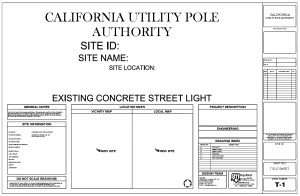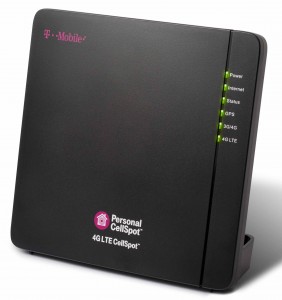 All of us at Telecom Law Firm wish a speedy and complete
All of us at Telecom Law Firm wish a speedy and complete
recovery to our friend, colleague, and always friendly opposition,
Stephen Garcia, Senior Manager of Government Relations at Crown Castle.
-Jonathan,
Let the games begin. The “California Utility Pole Authority” (the alter-ego DBA of Mobilitie”) is showing plans with their DBA in big loud letters. Here’s an example:

I obtained this public record document from a local government in California and redacted the site-specific identifiable information, including the site identification of the carrier Sprint which remains a secret. The specific site design proposed in the project was, in my opinion, simply awful. Strapping external conduits on concrete poles? Drip loops? Really? I don’t know of any savvy California governments that would entertain such a design.
Hopefully, Mobilitie the California Utility Pole Authority will learn quickly that a rather poor site design that may play in other parts of the country won’t play here in California.
By the way, at last count today, Mobilitie has registered DBAs as the following:
Alaska Utility Pole Authority
Arizona Utility Pole Authority
Arkansas Utility Pole Authority
Florida Utility Pole Authority
Georgia Utility Pole Authority
Illinois Utility Pole Authority
Indiana Utility Pole Authority
Minnesota Utility Pole Authority
Missouri Utility Pole Authority
North Dakota Utility Pole Authority
Ohio Utility Pole Authority
Oregon Utility Pole Authority
Pennsylvania Utility Pole Authority
Rhode Island Utility Pole Authority
Vermont Utility Pole Authority
West Virginia Utility Pole Authority
Wisconsin Utility Pole Authority
Wyoming Utility Pole Authority
Now that’s a LOT of Utility Pole Authority, if you ask me!
-Jonathan
GLOBAL TOWER ASSETS, LLC sued the Town of Rome, Maine and its Planning Board for a denial of a cell site project.
Unfortunately for Global Tower, it sued after receiving the Planning Board’s denial. It did not take an appeal to the Town. The District Court hearing the case “held that the Planning Board’s denial of the application was not a final action that Applicants were entitled to challenge under the TCA.” (Internal quotes omitted.)
Global appealed to the First Circuit Court of Appeals, which sustained the District Court’s ruling against the tower company. The Court of Appeals said,
The appellants contend that the opportunity to bring an
administrative appeal should not prevent their TCA challenge from
going forward. But, in keeping with basic principles of
administrative law and the purposes of the TCA, we disagree. As
a matter of state law, the planning board’s denial may be reviewed
in state court only after the local board of appeals has exercised
its own independent review. As a result, we agree with the
appellees — the planning board and the Town of Rome, Maine —
that the planning board’s decision does not mark the end of the
administrative process and thus is not a “final action” for TCA
purposes.
If you’d like to read the Court of Appeals’ decision, CLICK HERE.
This reminds me of a case I was involved in many years ago when NewPath Networks sued the City of Irvine before completing the administrative process.
Jonathan
My mentor and colleague, John Pestle of the Varnum, LLP and I teach online lectures about wireless leasing matters. We have taught these wireless leasing

lectures for many years. Our lectures, taught through Lorman Education Services and the International Municipal Lawyers Association focus on key things a wireless site landlord should be thinking about when entering into a decades-long cell site lease, or modifying a lease already in effect.
The number one question we get from our lecture participants is always the same: ‘How much is the going rent?’
John has a splendid way of answering that question. He replies socratically asking the question: ‘How much is an acre of land worth in the United States?’
The point, of course, is that every parcel of land is unique; therefore there cannot be a single right answer. Rather, the more complete answer is ‘How much is a specific acre of land worth to the Lessee and Lessor.’ The potential cell site landlord has one opinion of worth, while the potential wireless carrier tenant has its own view.
The question is then, how to figure out the ballpark.
You will find precious few wireless lease rates on the web. A few years ago, John and I conducted a national survey of lease rates for cell sites on government properties, and the findings can be summarized as follows: Lease rates are all over the map, but there’s a general range between a few hundred dollars per month to over $5,000 per month. What makes one cell site only worth a few hundred dollars a month and another many times that amount?
Location, location, location and need, need, need.
A cell site lease in a rural area will produce lease income for the landlord than will one in a suburban area. A downtown lease will most often induce a higher rent than a suburban lease. An interstate-adjacent lease will induce a higher rent than some downtown rents. A financial district lease is somethings at the top of the pile as goes rent.
Here’s a kicker…
What is an exceptionally desirable area to lease in for one wireless company can be completely worthless for another wireless company. That is because each carrier deploys it coverage in a different manner.
Consider each company’s coverage needs to be a jigsaw puzzle of the same outside dimensions, say 10 miles by 10 miles, which each puzzle having different shaped pieces to fill in the coverage picture inside the edges of the puzzle. A missing piece for one carrier might already be found and inserted for another.
Here’s another kicker…
Lease rates can be completely disconnected from the size of the leased area. That’s because the wireless carrier will often try and grab land claiming that some elements of your land are less valuable to them than others. They might say something like, ‘we value the space occupied by the equipment cabinets to be more valuable than the space occupied by the tower, so you should, too.’ (By the way, don’t fall for this sucker punch. Your land is most likely to have a single per square foot or per cubic foot rent (yes, some leases have three dimensions specified of height, width and depth, rather than the more common two dimensions of width and depth).
There’s more to say about this, and I will, but for now I’ll leave you with this…
BEWARE of leases where the wireless carrier wants to occupy a 100 foot by 100 foot space (10,000 square feet). This rather magic number is far greater than I’ve ever seen a wireless carrier need for its own site, which can be from 250 square feet to about 700 square feet. So why would a wireless carrier want the extra many thousands of square feet? So that it can sublease your land to other wireless carriers, broadcasters, two-way radio companies, paging firms (yes, they still exist) and the like so that your tenant can collect and put that subrent in their pocket instead of your.
There are some very effective means to avoid the sublease trap. We commonly implement those means in leases we write for landlords to maximize the sublease rental income of the wireless landlords who rely on our expertise and experience.
jlk
I’m simply amazed by the press coverage T-Mobile is getting from the announcement that it will offer free 3G/4G/4G-LTE hot spots. As their Fact Sheet says, “the 4G LTE CellSpot ensures customers with a limited signal will now have strong, dependable voice and data coverage in their home or small business.”

All you need to do is request one of these babies from T-Mobile, give them $25 as a security deposit, plug it in to the wall, hook it up to the Internet, and away you go.
And that’s a problem.
You have to pay for T-Mobile’s coverage in two more ways. First, you have to provide your own power to operate the unit. In the grand scheme, that’s not much money each year. I’m guessing something like $15. Then you have to connect this baby to your own internet connection, which then takes some undisclosed portion of your Internet to provide connectivity to the CellSpot. Have a slow connection…or dial up…then you might have a problem.
What’s the real problem, here?
The way I see it, this big splash in the press is a tacit admission by T-Mobile’s that its company-provided radio frequency coverage AND capacity is far less than adequate, especially for in-building service areas. Viewed that way, T-Mobile’s announcement appears to be painting flaming red lipstick on a pink porcine. Still not pretty.
So who can connect to these units?
I’m not sure. Traditionally, carriers have required cell site hotspot users to register their phones so that only they can use the hotspot. If T-Mobile goes the other way and allows any T-Mobile user to connect via any CellSpot, then there’s another problem: T-Mobile’s customers installing CellSpots are now also funding connectivity for T-Mobile to provide service to third parties.
Hey? What the GPS light?
If you noticed the GPS light on the photo of the CellSpot, good for y0u. That’s because this unit needs to be near an window what it can have a view of the heavens. Huh? The unit needs to receive reliable GPS data from GPS satellites so that T-Mobile knows where the unit is located. More huh? The FCC requires that all wireless carriers be able to identify the location of 911 callers. To meet this federal obligation, T-Mobile collects GPS data from each customer-installed unit so that it can tie the GPS location back to a 911 caller. That’s actually a good thing, especially if you want the fire department to know where you’re calling from in the event of an emergency.
The bad thing for GPS (and cellular reception) is that many high-rise buildings effectively interfere with outside reception they are large grounded metal boxes with hybrid metalized window tint that substantially reduces signal strength. Here’s a very informative YouTube video that illustrates my point:
The bottom lines in my view:
With this, I suppose that T-Mobile’s slogan that it is the “Un-Carrier” might be amended to claim that it is the “Un-Coverage-Carrier.” And that’s too bad since I think many of T-Mobile’s service plan offerings are innovative.
Here are the CellSpot tech specs published on T-Mobile’s web site:
Chipset
CPU: Broadcom 4708
Switch: in Broadcom 4708
2.4Ghz radio: Broadcom 4360
5Ghz radio: Broadcom 4360
RAM 256MB
Flash 128MB
Network standard
IEEE 802.11a/b/g/n/ac
IPv4
IPv6
Data rate
802.11a: 6, 9, 12, 18, 24, 36, 48, 54Mbps
802.11b: 1, 2, 5.5, 11Mbps
802.11g: 6, 9, 12, 18, 24, 36, 48, 54Mbps
802.11n: up to 450Mbps
802.11ac: up to 1300Mbps
Antenna External antenna X 3
Operation frequency
2.4Ghz Channel 1~11
5Ghz band1: 36~48
5GHz band4: 149~165
Security
64-bit WEP
128-bit WEP
WPA2-PSK
WPA-PSK
WPA-Enterprise
WPA2-Enterprise
WPS support
Firewall and access control
Firewall: SPI intrusion detection,DoS protection, IPv6 firewall
Access control: Parental control, Network service filter, URL filter, Port filter
Management
UPnP, IGMP v1/v2/v3, DNS Proxy, DHCP, NTP Client,
DDNS, Port Triger, Universal Repeater, System Event Log
SNMP (tender project only, not for retail)
TR-069 ( tender project only, not for retail)
VPN support
IPSec Pass-Through
PPTP Pass-Through
L2TP Pass-Through
PPTP server
OpenVPN server
PPTP client
L2TP client
OpenVPN client
Applications
Download master
Support BT, NZB, HTTP, ED2K
Support encryption, DHT, PEX and magnet link
Upload and download bandwidth control
Image: JPEG
Audio: mp3, wma, wav, pcm, mp4, lpcm, ogg
Video: asf, avi, divx, mpeg, mpg, ts, vob, wmv, mkv, mov
QoS
WMM
User definable rules for IP/MAC/Port.
Upload and Download bandwidth management.
ACK/SYN/FIN/RST/ICMP with Highest priority
Guest Network
2.4GHz guest network x 3
5GHz guest network x 3
Printer Server
Multifunctional printer support (Windows only)
LPR protocol support
File server: Samba and FTP server with account management
PPTP VPN server
Network map
Traffic monitor
WAN connection type
Internet connection type : Automatic IP, Static IP, PPPoE (MPPE supported), PPTP, L2TP
3G/ LTE USB dongle
Android USB tethering
Support dual wan fail over and load balance
Ports
4 x RJ45 for 10/100/1000/Gigabits BaseT for LAN
1 x RJ45 for 10/100/1000/Gigabits BaseT for WAN
USB 2.0 x 1
USB 3.0 x 1
Buttons
WPS button
Reset button
Power button
Wireless on/off button
LED
PWR x 1
AIR x 2
LAN x 4
WAN x 1
USB x 2
OS support
Windows® 8.1
Windows® 8
Windows® 7
Windows® Vista
Windows® 2000
Windows® ME
Windows® XP
Mac OS X 10.6
Mac OS X 10.7
Mac OS X 10.8
Mac OS X 10.9
Dimensions 220 x 83.3 x 160mm (WxDxH)
Weight 640g
Package content
1 x TM-AC1900 Wireless-AC1900 Dual Band Gigabit Router
1 x RJ-45 cable
1 x Power adapter
1 x QSG9
3 x Wi-Fi antennas
Special features
3G/4G data sharing
Printer server
AiDisK
Multiple SSIDs
Parental Control
VPN server
VPN client
My law firm professionals and I have negotiated hundreds of leases, lease modifications, agreements, ordinances, etc. over the years. We repeated hear the wireless carriers talk about the ‘rights’ they must have.
Nope. That’s not how it works for the savvy landlord.
We advise clients (and just about anyone else who will listen) that the wireless carrier is negotiating for privileges, not rights.
For example,
You get the idea…the boilerplate deals offered by carriers are hardly equal or fair to landlords. That’s a great reason to use an attorney who knows where the obvious (and the hidden) landmines are to be found in the documents, but I digress.
With the privileges the carrier seeks come payments to the landlord. The greater the bundle of privileges, the greater the payment to the landlord for granting those privileges.
Only when the lease is executed do the privileges convert to rights. Not one second sooner!
Landlords negotiating with the carrier’s agent (and all the better if the landlord has competent legal counsel helping…ahem…) should carefully listen for the words and phrases ‘rights’ or ‘we need’ or ‘we must have’ when uttered by the negotiator for the carrier. Every time that those words and phrases rear their ugly heads…and that will happy often…remind the rep that they are negotiating for privileges, which only convert to rights when the deal is done, fully valued, and the paperwork is fully executed.
The skill and mindset of the landlord’s negotiator for a cell site lease most often makes a huge difference in the result and value produced for the landlord.
We know that. Now you do, too.
Jonathan
I’m simply amazed by many of the tactics used by wireless carrier agents (and therefore condoned by the carrier masters).
Most recently, carrier agents for several big wireless carriers have starting telling potential cell site landlords that if those potential landlords retain the services of outside counsel to help negotiate the lease, there will be financial consequences. Sometimes the threat is the loss of a paltry signing bonus. Sometimes its reduction in the proposed monthly rent.
What strikes me about such threats is how two-faced they are. I know of exactly zero—zilch—nada— wireless firms that enter into lease without having their own attorneys review the documents first.
I tell clients that hear these threats that they should be even more cautious about entering into leases. The stock leases promoted by wireless carriers are, not surprisingly, aimed at grabbing as much as they can from the landlord while paying as little as possible for those grabs. Given that the leases usually run from 20 to 30 years* a landlord making a mistake or missing some well-hidden key point at the lease inception will haunt the landlord for decades.
Duck away from the sucker punch: If the carrier’s agent makes a veiled or direct threat in response to your decision to retain outside counsel, trust your gut. Someone who doesn’t want you to use an attorney has a very good reason for that, and it’s not because they want to do you a favor.
Welcome back to the government side of the planning counter, Sean Scully, as the new Planning Manager at the City of Redondo Beach, California.
After some time away ‘on the other side’ (no, I won’t call it the dark side) working for the wireless industry, Sean returns to his roots working for local governments. In the past Sean worked for the counties of Riverside, Santa Barbara and Monterey, as well as the cities of Carson, Menlo Park, and Lawndale.
Best of luck in your new position at the City of Redondo Beach.
-Jonathan
Rick Ellrod, the Director of the Communications Policy and Regulatory Division of the Department of Cbale and Consumer Affairs for Fairfax County, Virginia had a good idea regarding the electricity generating tree (read more HERE). Add some tiny illuminations to light of the tree at night.
Here’s my take on Rick’s idea: